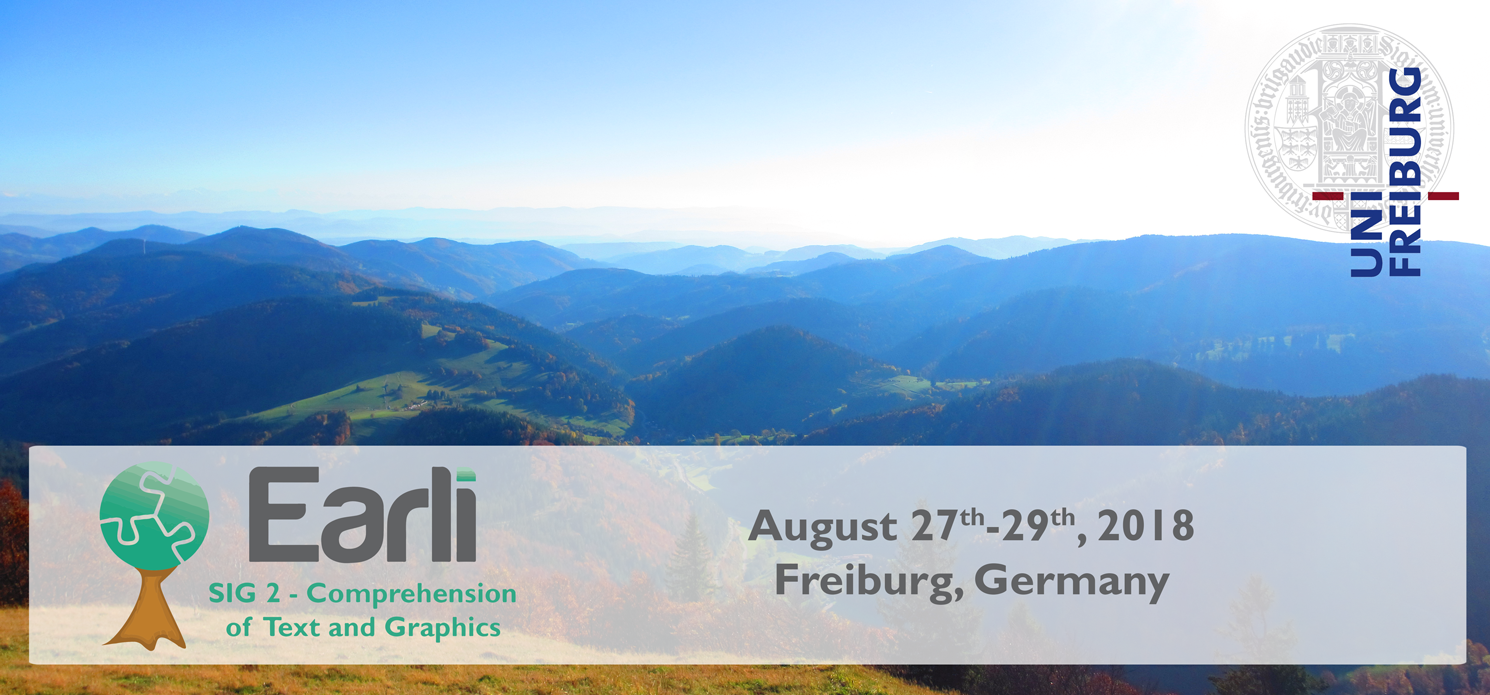
Theme
Important Dates
Save the dates!
-
Mid-JanuarySubmission system opens
-
February 17th 2018 at 23h59 (GMT+1)EXTENDED Deadline for submissions
-
April 26th 2018Notification of review decisions
-
April 30th 2018Registration opens
-
June 17th 2018Earli bird registration deadline
-
Sunday 15th, July 2018Presenters registration deadline
-
Monday 27th - Wednesday 29th, August 2018SIG 2 Meeting in Freiburg
Adjoint Events
Würzburg Summer School on Reading and Learning in the Digital World (READI) 2018
(Application deadline: April 15 2018)
Keynote speakers

University of Illinois at Chicago
when learning from text with graphics
Harp and Mayer (1998) delineated three classes of explanations for how the presence of images may undermine learning from text: diversion, disruption, and distraction. This keynote will consider new research consistent with a proposed fourth alternative: deception. Several studies have now demonstrated that the presence of images, or different types of images, can impact judgments of knowing, beliefs about learning, perceptions of understanding, and readers’ ability to monitor their own learning. The deception hypothesis prompts the question whether the presence of even relevant images (that depict information relevant to understanding a process, system or phenomenon) may sometimes serve as seductive details to readers.

University of Freiburg
In recent years, there have been lively discussions about the relevance of research findings on learning and instruction for practice. In many cases, even researchers have rather skeptic views whether their findings allows for such codified recommendations as they can be found in the medical domain (i.e., evidence-based medical guidelines). In the present talk, I will take a more optimistic view on the relevance of research on learning and instruction. I will illustrate my arguments for the case of learning from multiple representations. More specifically, I will argue that we should not follow the medical model of evidence-based practice that focusses on systematic reviews, ideally in the form of meta-analysis, for providing specific guideline on action. Instead, I take up the motto of the present conference ("Forest before trees: Towards identifying general patterns in text and graphics research") and argue that we should use general patterns of findings on learning from multiple representations for a variety of different types of "recommendations" (e.g., "warnings" or "showing up possibilities").

Leibniz Institute for Science and Mathematics Education (IPN)
Principles on how to best learn from multimedia (i.e., learning with text and pictures) have been thoroughly studied and received much attention for decades. However, visualizations such as representational or decorative pictures also play an important role in materials constructed for testing students’ knowledge and competencies (e.g., in educational assessment programs). Can we simply transfer multimedia principles from learning to testing? How do students use multimedia material in their response process when answering test items, and is there an interaction between the effects of learning and testing with multimedia material? In an effort to address these questions, I will present several empirical studies that shed some light on the cognitive and the affective-motivational effects of different picture types in testing, with the help of process measures such as eye tracking parameters, response times and repeated student ratings. The findings reveal noticeable similarities between effects found for multimedia learning and multimedia testing. However, they also indicate how research in both areas may be mutually beneficial and stimulating.
Registration and Presentations
Registration
Go to the registration page for information about this meeting's fees and online registration procedure through the EARLI conference system.
/!\ Presenters' registration deadline is Sunday 15th, July 2018.
Presentations
 Oral presentations
Oral presentations
Presenters have 15 minutes for presentation and 5 minutes for the discussion with the audience.
Practical information: You can plug in your laptop (both apple & windows), but the room is equipped with a computer and it is probably easiest to start your presentation from there (from USB stick or cloud); there is also sound and internet available for your presentation. Please check in the pauses before sessions whether your presentation runs (you can also ask our local staff).
See the program overview to find your session.
 Poster session
Poster session
Maximum poster size : ISO A0, in portrait format (H 120cm x W 84cm). See the poster guidelines for more details.
Practical information: Please bring your posters to the information desk at the entrance of the lecture building, from Monday until Tuesday during lunchtime; we will hang them on walls on the 1st floor (SR A+B) where the poster session takes place. During the poster session, odd poster numbers will be presented first (45 minutes), and even poster numbers will be presented second (45 minutes)
Poster session will take place on Tuesday, August 28th from 14:30 until 16:00.
 Roundtables
Roundtables
Will take place on Monday, August 27th from 14:30 until 16:00.
Practical information: There will be three parallel, thematically-clustered roundtable sessions with three topics each (max. time is 90 minutes). We recommend that presenters prepare handouts or use a digital device to illustrate ideas; we also recommend to prepare two or three open questions for discussion. Please make sure to stay within 15 min presentation + 5 min time for discussion, so that there is 30 min time for an overall discussion at the end of the session. Rooms are equipped with a laptop, which is available if needed.
Submission through the EARLI conference system is now closed.
The call for this meeting is available bellow.
Venue and Organization
The 2018 SIG2 meeting is operated by the University of Freiburg. 
Learn more about...
- The meeting's venue
- The committees working behind the scene
Organizing committee
Alexander Eitel (conference chair, SIG coordinator)
Mireille Bétrancourt (SIG coordinator)
Janina Lehmann (JURE SIG coordinator)
Juliette Désiron (former JURE SIG coordinator).
Contact: SIG2@earli.org
Sponsors
![]()
![]()

